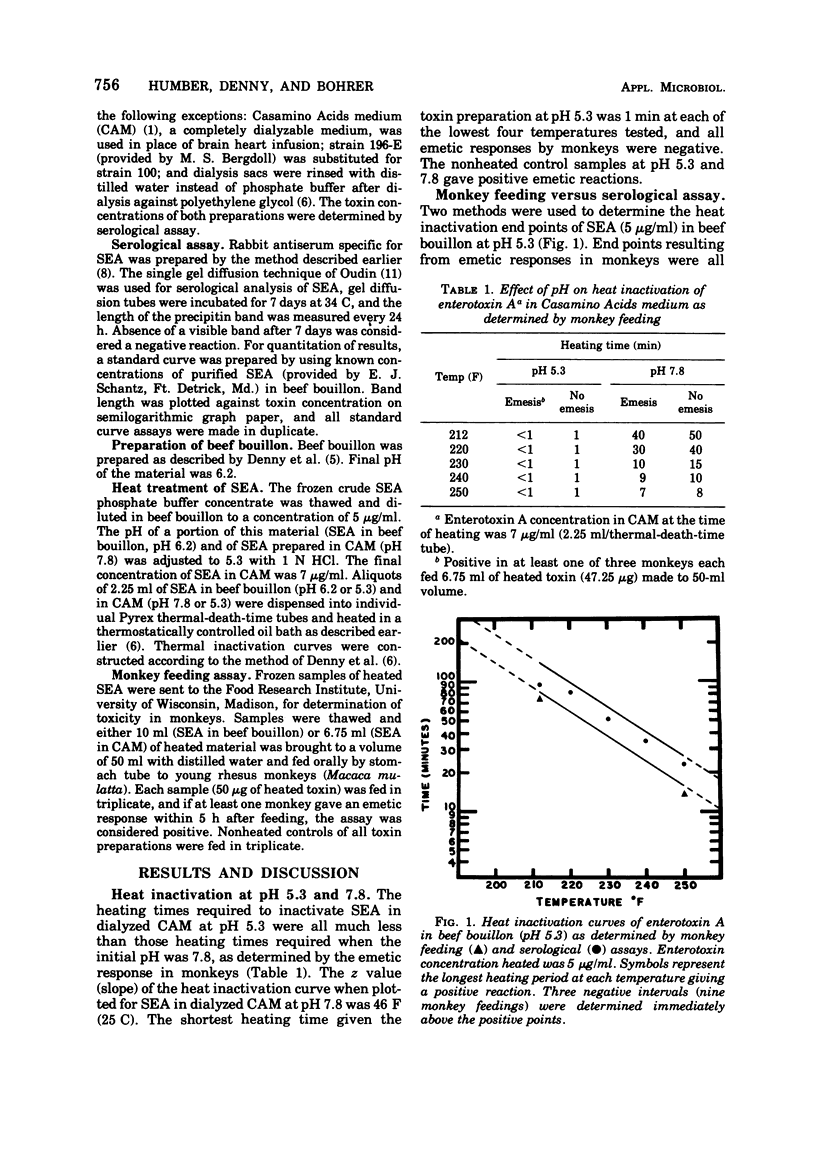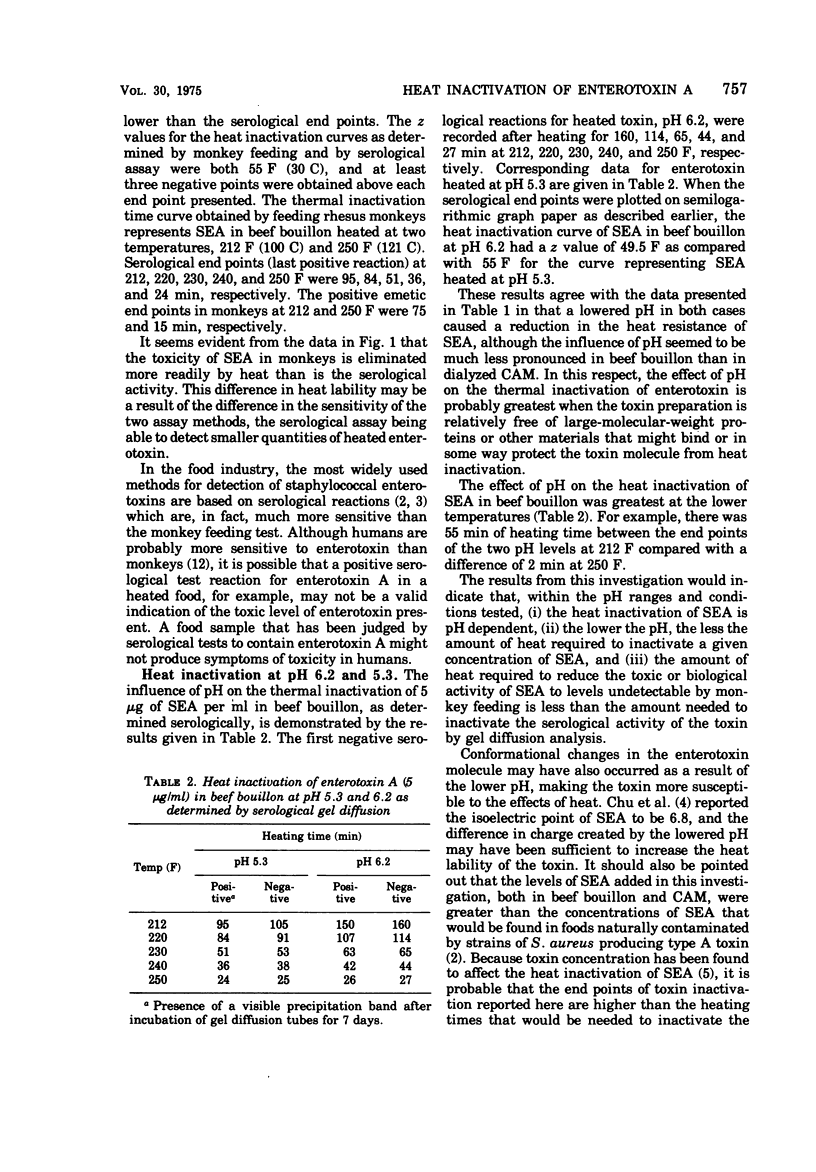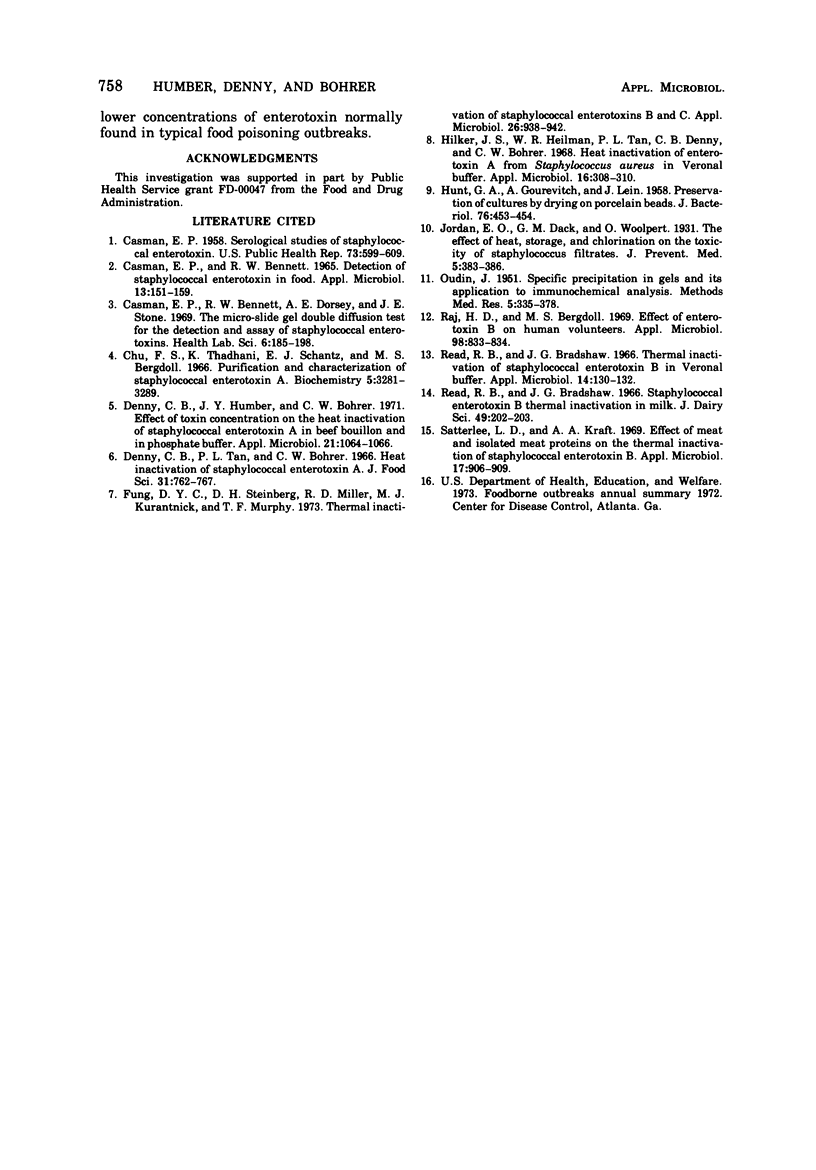Abstract
The effect of pH on the thermal inactivation of staphylococcal enterotoxin A was investigated. Analysis of heated toxin by immunodiffusion in gel indicated that enterotoxin A in beef bouillon was inactivated faster at pH 5.3 than at pH 6.2. The z values (slopes) for the heat inactivation curves at pH 6.2 and 5.3 were 49.5 and 55 F (about 27 and 30 C), respectively. Enterotoxin produced and heated in dialyzed Casamino Acids medium and assayed by monkey feeding was more easily inactivated by heat at pH 5.3 than at pH 7.8. Thermal inactivation curves for enterotoxin A in beef bouillon (5 μg/ml, pH 5.3) were determined by two methods, monkey feeding and serological assay. The z values for the curves obtained by these two methods were both 55 F, although loss of biological or toxic activity of the enterotoxin occurred before loss of serological activity.
Full text
PDF



Selected References
These references are in PubMed. This may not be the complete list of references from this article.
- CASMAN E. P. Serologic studies of staphylococcal enterotoxin. Public Health Rep. 1958 Jul;73(7):599–609. [PMC free article] [PubMed] [Google Scholar]
- Casman E. P., Bennett R. W., Dorsey A. E., Stone J. E. The micro-slide gel double diffusion test for the detection and assay of staphylococcal enterotoxins. Health Lab Sci. 1969 Oct;6(4):185–198. [PubMed] [Google Scholar]
- Chu F. S., Thadhani K., Schantz E. J., Bergdoll M. S. Purification and characterization of staphylococcal enterotoxin A. Biochemistry. 1966 Oct;5(10):3281–3289. doi: 10.1021/bi00874a030. [DOI] [PubMed] [Google Scholar]
- Denny C. B., Humber J. Y., Bohrer C. W. Effect of toxin concentration on the heat inactivation of staphylococcal enterotoxin A in beef bouillon and in phosphate buffer. Appl Microbiol. 1971 Jun;21(6):1064–1066. doi: 10.1128/am.21.6.1064-1066.1971. [DOI] [PMC free article] [PubMed] [Google Scholar]
- Fung D. Y., Steinberg D. H., Miller R. D., Kurantnick M. J., Murphy T. F. Thermal inactivation of staphylococcal enterotoxins B and C. Appl Microbiol. 1973 Dec;26(6):938–942. doi: 10.1128/am.26.6.938-942.1973. [DOI] [PMC free article] [PubMed] [Google Scholar]
- HUNT G. A., GOUREVITCH A., LEIN J. Preservation of cultures by drying on porcelain beads. J Bacteriol. 1958 Oct;76(4):453–454. doi: 10.1128/jb.76.4.453-454.1958. [DOI] [PMC free article] [PubMed] [Google Scholar]
- Hilker J. S., Heilman W. R., Tan P. L., Denny C. B., Bohrer C. W. Heat inactivation of enterotoxin A from Staphylococcus aureus in veronal buffer. Appl Microbiol. 1968 Feb;16(2):308–310. doi: 10.1128/am.16.2.308-310.1968. [DOI] [PMC free article] [PubMed] [Google Scholar]
- OUDIN J. B. Specific precipitation in gels and its application to immunochemical analysis. Methods Med Res. 1952;5:335–378. [PubMed] [Google Scholar]
- Raj H. D., Bergdoll M. S. Effect of enterotoxin B on human volunteers. J Bacteriol. 1969 May;98(2):833–834. doi: 10.1128/jb.98.2.833-834.1969. [DOI] [PMC free article] [PubMed] [Google Scholar]
- Read R. B., Jr, Bradshaw J. G. Staphylococcal enterotoxin B thermal inactivation in milk. J Dairy Sci. 1966 Feb;49(2):202–203. doi: 10.3168/jds.S0022-0302(66)87827-X. [DOI] [PubMed] [Google Scholar]
- Read R. B., Jr, Bradshaw J. G. Thermal inactivation of staphylococcal enterotoxin B in veronal buffer. Appl Microbiol. 1966 Jan;14(1):130–132. doi: 10.1128/am.14.1.130-132.1966. [DOI] [PMC free article] [PubMed] [Google Scholar]
- Satterlee L. D., Kraft A. A. Effect of meat and isolated meat proteins on the thermal inactivation of staphylococcal enterotoxin B. Appl Microbiol. 1969 Jun;17(6):906–909. doi: 10.1128/am.17.6.906-909.1969. [DOI] [PMC free article] [PubMed] [Google Scholar]


